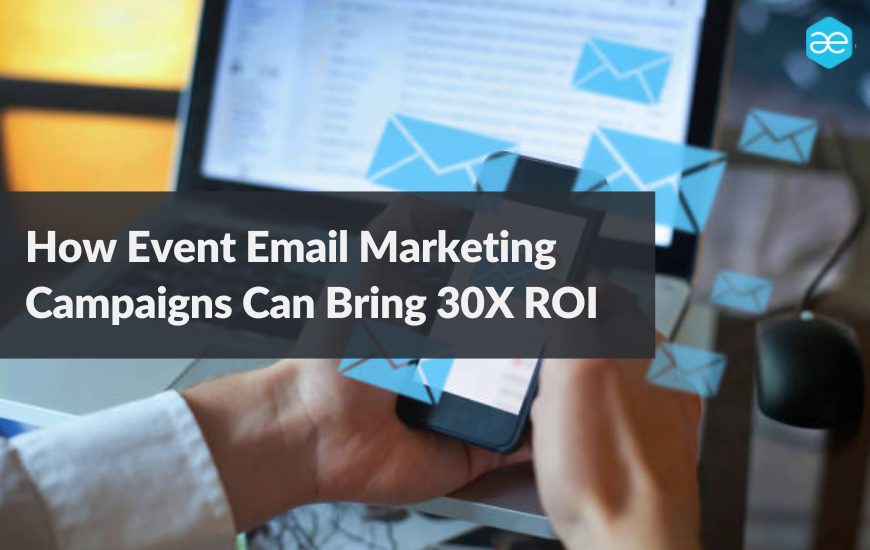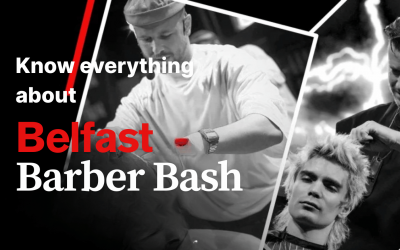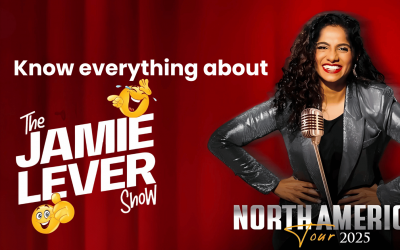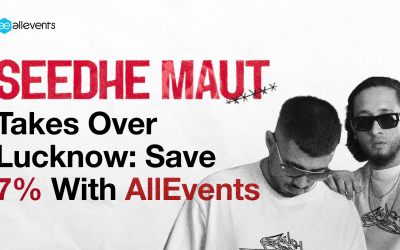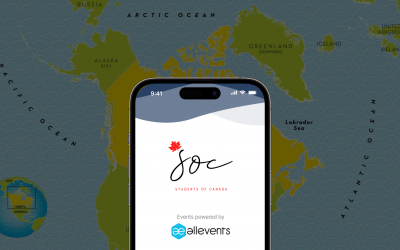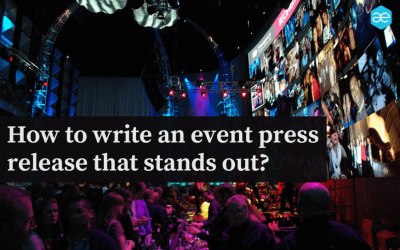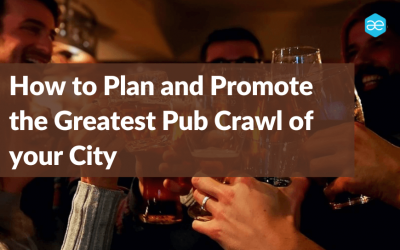After 12 years of experience and many failed and successful campaigns, we have created a full-proof Event Email Marketing guide.
If you are just now starting with email marketing for events or need a refresher, here are eight key elements for driving at least 30X ROI from your upcoming email campaigns. This guide will be helpful to you only if you read it and put it into practice.
Fun fact: According to Statista, the worldwide market for e-mail marketing was worth 7.5 billion U.S. dollars, and it is expected to grow to 17.9 billion U.S. dollars by 2027.
Event email marketing is a small part of event marketing! If you want to know everything about event marketing, Consider using this → Event Marketing Guide ← for insights and tips!
What is Email Marketing for Events?

Email marketing is one of the most lucrative ways to promote your upcoming event. The event marketing process involves planning, promoting, executing, and evaluating an event to achieve marketing objectives. It has the potential to generate viral interest and attract new attendees, as well as retain existing customers.
Myth buster: Email marketing is about more than just broadcasting your message to a large audience. It’s also about maintaining contact with your attendees.
What can you do with event mailers?
- Notify people about upcoming events.
- Keep them up-to-date on event details and send reminders.
- Provide opportunities to encourage attendees to share their experiences.
Do you know why event marketers prefer email marketing over other means of promotion? Keep reading to find out!
Why Event Email Marketing is important?
The best email marketing practices are crucial for event marketing for businesses, regardless of their size.
Advantages of using email blasts for mail marketers:
- It’s one of the most budget-friendly ways to contact your intended audience.
- By offering valuable information, you can encourage them to interact with your brand and become active customers.
- It can enhance your search engine rankings and boost your website traffic when utilised properly.
Want to take your email campaigns to the next level? Schedule a call with AllEvents’ event marketing experts today and learn how we can help you create exclusive campaigns that engage your audience and drive real results.

How do you Market an Event through Email?
With emails, you can reach out to your audience with a targeted campaign that will make sure they know about your event.
Here are the obvious but most neglected steps for the best event email marketing:
1. Figure out your audience
Who are you trying to reach? What are their interests? What do they care about? How can you reach them in an authentic way that fits with the kind of person they are?
For example, Conferences are generally open to the public, so your email marketing strategy might focus on building excitement and generating interest in the event.
2. Find ways to connect with them
Do they have social media accounts? Do they like getting postcards in the mail? Can you send them something to make them remember your event and want to return for more?
3. Targeting is key
Targeting is vital in marketing. You can’t just send the same message to everyone and assume it will resonate.
For instance, picture yourself attending a conference organized by a powerful corporation and sponsored by numerous smaller brands and businesses.
How would you personalize your marketing message to promote a conference to differentiate yourself and establish a connection with each individual in that crowd?
Trade shows or expos vary from conferences in some ways. That implies you have a more specific audience to focus on. To improve your email marketing, you can use the 80/20 rule. This means you focus on the 20% of your subscribers who are most active and likely to take action. Group based on how they behave and what they like, and target them.
Pro Tip: You can also try and learn to target your audience through event advertising campaigns.
What are the Three Types of Marketing Emails?

After testing various email campaigns, we created three categories to sort our emails. These categories will help you get the most out of your email marketing efforts.
1. Promotional Emails
These are the most frequently used type of email and have a significant impact on ticket sales. Don’t underestimate their importance. Use them to announce new events, early bird ticket sales, and special discounts or to remind your audience to purchase tickets before the deal ends.
2. Transactional Emails
While these emails may not greatly impact revenue, they are crucial for building brand value and awareness. These emails are usually triggered by user actions, such as purchasing tickets or sharing your event on social media. Marketers use these types of emails to thank attendees and increase engagement. These emails provide attendees with additional information about their recent activities and encourage them to share your event with others.
3. The relationship-building email
High impact, but it depends on how you market it. For instance, you can share your event’s “funny behind the scenes” with attendees to create a fear of missing out and make them interested in coming.
Or you can create an aura of suspense and offer a surprise event or celebrity so they will be eager to refer the event to their family and friends.
In short, You will be focusing on building one-one connections with your followers and attendees.
Top 5 Tips to Improve the success rate of Your Email Marketing Campaign
When people receive tons of emails every single day, will your mail stand out? Email is divided into four parts. The 4 parts of an email include the subject line, body content, call-to-action, and ending.
Craft each part perfectly for conversion!
Yes? Then consider the following points that might change your mind.
Write compelling Event Email Subject Lines
On average, a person receives more than 100 emails per day. Out of those, ten are barely opened.
Many email campaigns go unnoticed by the target audience because they don’t have a catchy subject line.
Pro tip: To get your email opened by attendees, you need to add something that would feel like genuine clickbait.
Here I have explained and given some catchy email subject lines to help you skyrocket the open rate.
Craft compelling content that captivates your audience’s attention
Only spend hours writing and editing something to see it succeed. Keep this checklist in mind to finish the job quickly and effectively!
- Keep it concise and to the point
- Ensure that your content resonates with your target audience
- Utilize images and videos to enhance engagement
- Use language that your audience understands
- Write with authenticity rather than using a generic template
Pro tip: Keep your recipient in mind while developing your email campaign to create content that establishes a connection and inspires action.
Optimize CTA in your Emails
We recently observed that optimizing your call to action (CTA) can increase conversions by up to 20%. Here’s how:
- Use a CTA that matches the offer. If you’re offering something specific, like “Download our toolkit,” then use that exact phrase in your CTA. If you’re offering something broader, like “Check out our new blog posts,” use something like “Learn more”.
- Avoid using a strong verb for the CTA. You need to ensure that you avoid words that would increase the spam words.
Note: When someone reads an email, they’ll often scan it without reading every word—they’ll read only what interests them at the beginning of each sentence or paragraph.
Pro tip: The most important information should come first so that readers can easily see what they want immediately.
Select awesome pre-event and post-event Templates
What kind of emails do you think people prefer? Do they like dull emails with long paragraphs? Not! People prefer well-designed emails that catch their attention and encourage them to take action.
Here’s a tip to enhance email engagement: Use HTML emails. Event marketers frequently use these and don’t require coding skills, as numerous eye-catching email templates are available to make your job easier.
Three steps to send HTML emails:
- Download free templates
- Edit file in an HTML editor like sublimetext
- Copy-paste that code into the email sender
OR
- List your events on AllEvents
- Import subscribers
- You can automatically send an HTML invitation email to your attendees for FREE
Don’t be pushy! And don’t Spam!
One thing that people don’t like is getting poked every now and then. So, you need to give them space such that they convert instead of hitting the unsubscribe button.
The first thing you need to do is, segregate your leads. Then prioritize and schedule your emails. Also, ensure that you only send one mail in 2-3 days, or else they’ll get bugged.
Pro tip: This is extreme, but if someone has yet to open an email from you in a month or two (or even three), it’s probably time for them to go on an unsubscribe list. Why? Scroll down!
Avoid this mistake while launching campaigns!
We once received a letter from overseas just because we kept sending them promotional emails even though they were uninterested.
Event Email Marketing Example that got us 34X ROI

Now here comes the exciting part. Out of our many high-yield mail blasts, one typical mailer caught our eye.
We launched a campaign where we only intended to give value. But we ended up with significant returns.
What was the Mailer about?
The objective was to help event organizers to get leads and sell tickets. To do this, we sent custom mailers to their followers so that they would be notified about the new events.
Here’s an example of a mail for our organizer pH Designs.
What did we do differently?
We knew the best options wouldn’t make the receivers compelled to read it.
So, we dived into the perspective of the recipient. We kept the name of a client with whom we had interacted and kept them as a reference while drafting the mail.
The above method might seem odd, but trust me; you’ve already crossed the most significant hurdle if you try this.
Next was to improve the open rate. The subject line had to be optimized. To do this, we made the content catchy and made it personalized. To add a cherry on top, we embedded emojis. For instance, early bird tickets gets attendees a sense of urgency to buy tickets.
Pro tip: We check the email’s readability with mobile and desktop before launching it.
Never forget A/B testing
This is something that we have drilled into our minds. We’ve ingrained this practice in our minds: creating 3-4 versions of the email and testing them to see which one performs the best.
It’s essential to keep in mind to make the testing period shorter or shorter, as it could result in wasting time or not having enough test data.
Pro tip: To get a better look at our marketing campaigns, take a look at how we pushed 800+ tickets sales in Jewelry Exhibition.
Let’s conclude our discussion on Email Marketing for Events…
So, what did we learn? First, we learned that event email marketing campaigns could increase your ROI multifold.
To maximize the impact of your event marketing, it’s essential to consider how you can communicate with your audience in a personalised and effective way using an email marketing platform.
By crafting compelling event promotion emails that showcase the benefits of attending your upcoming event, you can entice potential attendees and encourage them to register. Whether promoting virtual or previous events, a well-crafted event marketing strategy can make all the difference.
This article has provided valuable insights into the effectiveness of successful event email marketing campaigns and how you can leverage them to achieve significant outcomes for your business. Best of luck with your next campaign!
FAQs:
What is an event email marketing campaign?
An event email marketing campaign is a promotional tactic that utilizes an email marketing platform to advertise a specific upcoming event, such as a conference, trade show, webinar, or product launch.
What is the goal of an event email marketing campaign?
The main purpose of an event email marketing campaign is to create excitement and encourage attendance at the event while showcasing the event’s sponsors and exhibitors. A successful event marketing strategy can help increase attendance and engagement, generate leads, and boost ROI.
What are some tips for creating an effective event email marketing campaign?
To create an effective event email marketing campaign, it is important to segment your email list, use catchy subject lines, provide valuable and pertinent content, incorporate clear calls-to-action, and test and optimize your email content. Promoting virtual events or previous successful events can also help generate interest.
How do you measure the success of an event email marketing campaign?
To measure the success of an event email marketing campaign, you can keep track of metrics such as open rates, click-through rates, registration rates, and revenue generated from ticket sales or sponsorships. Analyzing these metrics can help you identify what worked well and what needs improvement for future campaigns.
When should you start an event email marketing campaign?
When planning an event email marketing campaign, it’s essential to consider the type and size of the event, as well as the target audience. As a general guideline, starting the campaign at least 6-8 weeks before the event is recommended to give potential attendees enough time to plan and register.
What are some common errors to avoid when creating an event email marketing campaign?
Sending only a few emails to avoid overwhelming the recipients.
Not Personalizing the content to make it more engaging and relevant.
Not using specific and clear subject lines to grab the reader’s attention.
Not Providing a clear call to action so recipients know what to do next.
Not Promoting virtual events effectively, tailoring the message to different audiences.
